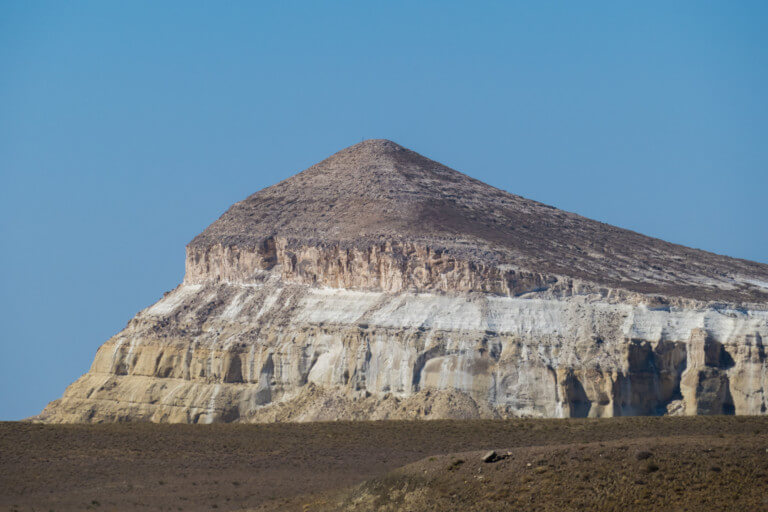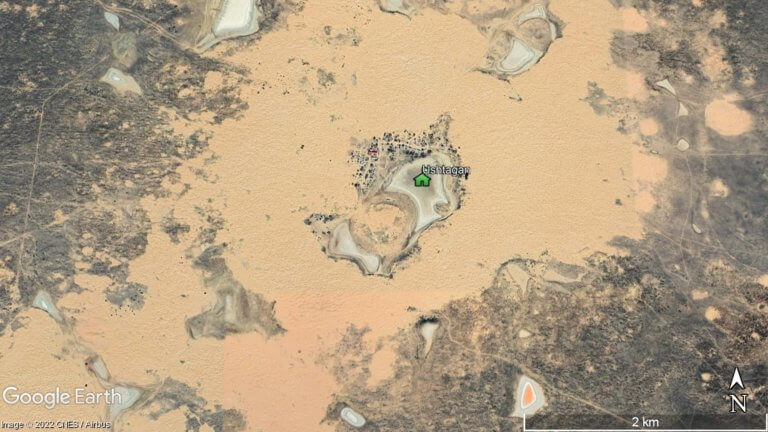
Karynzharyk Depression
Karynzharyk is an 85km long and 15km wide depression in the Ustyurt Nature Reserve. The nearest village is Ak-Kuduk, which is situated 25km to the
Overlooking Dead Kultuk is New Alexander Fort. It’s on the cliff edge of the Western Chink Ustyurt, on the east side of Kaydak Bay, and was in use from 1834–1846. Russian General Vasily Perovsky, who oversaw two attempts to conquer Central Asia in the Khiva and Kokand campaigns, ordered the fort to be built after hearing about Karelin’s successful reconnaissance of the area. His plan was to use it as a base to catch Caspian Sea pirates, establish trade relations with Central Asia’s khanates, and to gain authority over Mangystau’s residents. They deemed the fortress unsuitable for long-term use because of logistical difficulties: sailing into the bay was harder than expected; unloading and transporting supplies from the ships required carrying them uphill to the fort; and there was insufficient water for both the men and horses.
All that remains today are building foundations and a few hundred metres of defence walls built out of densely packed rows of standing stones designed to deter would-be attackers on horseback. Two hundred metres downhill of the main fortification is a collection of buildings, which were undoubtedly used as sleeping quarters and for the storage of armaments and supplies.
Thirty-five kilometres south-west of the fort is Sisem Ata Necropolis, located a couple of kilometres inland of Kaydak Bay’s cliffline. It’s one of Mangystau’s largest and oldest necropolises, measuring 350m wide and dating back to the 11th–12th century. According to archaeologist Alan Medoev, who researched many Old Stone Age sites and petroglyphs in Central Asia, the Sisem Ata area is considered the genesis of the Mangystau Region’s present-day peoples. The necropolis has hundreds of stone-constructed tombs and earth embankments, and is named after a medieval-era Islamic preacher who lived during the Oghuz-Kipchak period. Numerous batyrs from the Adai tribe* are buried here, many of whom died in battles against the khans of Khiva.
According to the local Ministry of Culture, Uali Necropolis is 60km north-east of Say-Otes settlement, which is on the A-33 road leading to the fort, and next to a salt pan. However, we haven’t been able to find it during our satellite image search. If you go looking for it, keep your eyes peeled for any signs along the A-33. It dates back to the medieval era and has over 300 burial monuments, as well as a single-chamber underground mosque in the southern part of the complex.
New Alexander Fort (Novo-Aleksandrovskii Bekınısı/Ново-Александровский форт): 44.9051, 53.8091
Sisem Ata Necropolis (Sisem Ata Keşenı/Некрополь Сисем Ата): 44.6211, 53.5834
Say-Otes (Sai-Ötes): 44.3259, 53.5381
Estimated Location of Uali Necropolis (Uäli Qorymy): 44.4631, 54.2659
1:200k Soviet map of Kaydak Bay. The fort is shown at the top of the bottom-right quarter, on the north side of the Western Chink Ustyurt.
1:200k Soviet map of Western Chink Ustyurt south of the fort, with the western Buzachi Peninsula in the top-left quarter.
Drone video of New Alexander Fort and the bay.

Karynzharyk is an 85km long and 15km wide depression in the Ustyurt Nature Reserve. The nearest village is Ak-Kuduk, which is situated 25km to the

Sherkala (332m) is 5km west of Ayrakty-Shomanai on the northern side of the West Karatau Range. Its name is derived from the Persian words for

The Ryn, also known as the Naryn Sands, is Kazakhstan’s westernmost desert. It spans for over 350km between the Volga and Ural Rivers, and over
Copyright © Planet Esoterica, 2024. No part of this site, www.planetesoterica.com, may be reproduced in whole or in part in any manner without the permission of the copyright owner. All rights reserved.
Made with 